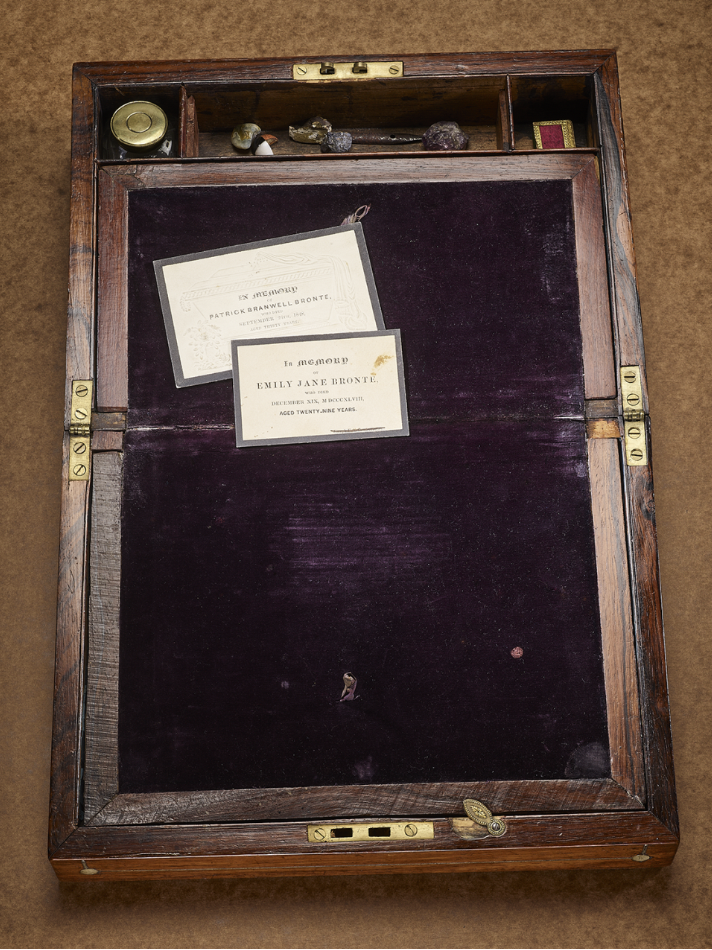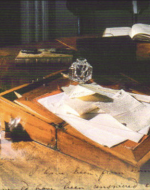Created by Ella Palmet on Thu, 11/10/2022 - 15:56
Description:
Writing desks were common amongst the middle and upper classes in the Victorian era. They were easily transportable, ensuring writing in the most productive environment. There were compartments towards the top for writing implements, as well as letter writing materials. Many desks contained valuable information, such as money, jewelry, passports, and wills. Even though there were different types of desks, the secret compartments were often located by the inkwell compartment or by the release button. Desks required a key and lock. The Brontë's owned the most common type of desk of the four major types. They were shaped like a rectangular box with a hinged slope, revealing storage space underneath.The writing desks of the Brontë sisters were prized possessions, which they utilized to compose their famous novels and poems. Each desk held a significant amount of personal meaning as each one held secret possessions and precious ideas, among other things. They even incorporated writing desks within their novels.
"Charlotte Brontë's Writing Desk," 1855, New York Public Library. This image depicts Charlotte Brontë's writing desk, hidden for over a century. On this very desk, Charlotte wrote Jane Eyre and collaborated with her sisters to create their own poetry book. The desk is cut from mahogany and velvet, slanted and easily portable, with smaller compartments for paper, ink, and square nibs. In 1973, the larger central compartment was opened to reveal Charlotte's personal belongings as well as memorial cards addressed to Emily and Branwell. According to the Brontë Parsonage Museum, each sister's desk also contained cards, letters, and myriad seals. Through Charlotte's writing desk, we glean her writing process. According to the FineBooks Magazine, Charlotte's writing process required a significant amount of precision, as indicated by the paper and glue residual marks on her manuscripts, which meant that she wrote on top of her drafts. This process was incredibly intricate. Charlotte sometimes wrote with her eyes closed in order to preserve her inner ideas without interference from her surroundings. Additionally, she kept in her desk pens, blades and rulers to edit and produce multiple drafts in order to meet publishers' guidelines.
Sources: Richter, Barbara Basbanes. “Reading the Writing Desk: The Instruments the Brontës Used to Craft Their Novels.” Fine Books & Collections, 1 Nov. 2019, https://www.finebooksmagazine.com/blog/reading-writing-desk-instruments-... ; “Parsonage Unwrapped: The Brontë Desks.” The Bronte Society, https://www.bronte.org.uk/whats-on/925/parsonage-unwrapped-the-bronte-desks ; Heritage, Barbara. “Reading the Writing Desk: Charlotte Brontë's Instruments and Authorial Craft.” Studies in Romanticism, Johns Hopkins University Press, 3 Feb. 2022, https://muse.jhu.edu/article/846627.
"Emily Brontë's Writing Desk," Brontë Parsonage Museum. The image above depicts Emily's writing desk, which is on display at the Brontë Parsonage Museum in Haworth, UK. Emily's desk was portable and made of rosewood with a purple velvet slope. She reffered to it as her "desk box," which she perched on her lap or a table. She also enjoyed writing in her bedroom, in the parlor with Anne, or outside. When she did write outside, her small wooden stool accompanied her. According to The Lady, the abundance of materials was difficult for a single person to hold all at once, and this was a "careful balancing act." However, this challenge did not distract her in the slightest; rather, it fueled her creativity. She even created her own self portraits in this position. In terms of writing implements, Emily kept envelope seals, wooden pens, and blotting paper in a compartment at the bottom of her desk. Her desk also leaves behind clues about her writing process. Emily used scraps of paper to write poems or short essays. She practiced her tiny writing on these scraps. She continually rewrote poems in her notebooks, discarding the old ones once she was finished with them. She stored her scrappy papers, self portraits, and notebooks in her writing desk.
Sources: The Brontë Cabinet: Three Lives In Nine Objects, by Deborah Lutz ; “The Write Things.” The Write Things, https://lady.co.uk/write-things.
“Anne Brontë's Writing Desk, 2012, flickr.com. Not much is known about Anne’s writing desk. She also typically did her work in the parlour. Anne kept materials similar to those of her sisters' in her desk: blotting paper, calling cards, black crayon, pencils, quill pens, as well as paper and postage stamps. Additionally, Anne shared quill cutters and tracing paper with her sisters.
Sources: Heritage, Barbara. “Reading the Writing Desk: Charlotte Brontë's Instruments and Authorial Craft.” Studies in Romanticism, Johns Hopkins University Press, 3 Feb. 2022, https://muse.jhu.edu/article/846627 ; “ANN BRONTE'S WRITING DESK.” Flickr, Yahoo!, 21 October, 2012, https://www.flickr.com/photos/summonedbyfells.
“The Dining Room,” Brontë Parsonage Museum. This image depicts the dining room table where the sisters wrote Jane Eyre (1847), Agnes Grey (1847), and Wuthering Heights (1847). The sisters referred to this room as the “parlour.” Crimson-colored and furnished with bookshelves, the dining room held a table for the sisters' writing desks and provided a setting for contemplation and creativity. The primary source of lighting in the room was either oil lights or candles, contributing to the comfortable ambiance. Charlotte even refers to this atmosphere in one of her poems, remarking the room’s warm environment juxtaposed against a snowy night. Not only was the table itself a fundamental part of their writing process, but the entire room was. The sisters brought their writing desks into the parlour and sometimes recited their writing. They often took brief strides around the table in order to help with their creative process and to plan out what they were going to write. This nighttime routine continued for Charlotte even after the death of her sisters. The desk is currently housed at the Brontë Parsonage Museum in Haworth, UK.
Sources: Heritage, Barbara. “Reading the Writing Desk: Charlotte Brontë's Instruments and Authorial Craft.” Studies in Romanticism, Johns Hopkins University Press, 3 Feb. 2022, https://muse.jhu.edu/article/846627 ; “The Dining Room” Brontë' Parsonage Museum, https://www.bronte.org.uk/museum-and-library/inside-the-parsonage/dining... ; “The Parlour by Charlotte Brontë.” By Charlotte Brontë - Famous Poems, Famous Poets. - All Poetry, https://allpoetry.com/The-Parlour ; “Bronte Writing Table Goes on Show at Haworth Parsonage.” BBC News, BBC, 1 Feb. 2015, https://www.bbc.com/news/uk-england-leeds-31081150.
"To Walk Invisible: The Brontë Sisters", 2016, pbs.org. This is a still from a British television film, which focused on the Brontë family dynamics, regarding each sister's publishing careers, Branwell's descent into alcoholism, and their father's illnesses. Prior to the publishing of Poems by Currer, Ellis and Acton Bell (1846), Charlotte discovered Emily's remarkable poetry by snooping through her writing desk, revealing her private collection. In the movie, Emily is not keen on the idea of publishing her work, while Charlotte desperately tries to convince her to share her work. The still above depicts this very moment of conflict and Emily's reaction to her privacy and property being invaded. This reaction is indicative of the incredible personal attachment and importance that Emily associated with her desk. This reveals secrecy within the sister's lives and how small and hidden compartments were included in desks to conceal whatever the owner may have wanted.
Desks were a plot device in Anne Brontë's novel The Tenant of Wildfell Hall (1848). In Helen's attempt to escape her husband, Arthur Huntingdon, he reads her diary and finds the money set aside in her secret desk drawer, after snatching her keys away. This discovery of her secrecy angers him, causing him to revert to verbal abuse.
Sources: “To Walk Invisible.” Wikipedia, Wikimedia Foundation, 5 Oct. 2022, https://en.wikipedia.org/wiki/To_Walk_Invisible. ; DeBolt, Virginia. “Review: To Walk Invisible: The Brontë Sisters.” Old Ain't Dead, 6 Nov. 2017, https://oldaintdead.com/review-to-walk-invisible-the-bronte-sisters/. ; Mumford, Tracy. “'The Bronte Cabinet' Explores Lives of Literary Sisters.” MPR News, MPR News, 14 July 2019, https://www.mprnews.org/story/2015/06/15/books-thread-bcst-bronte-cabinet. ; Golden, Catherine. “The Portable Writing Desk — the Victorian Laptop.” The Portable Writing Desk - the Victorian Laptop, 7 June 2010, https://victorianweb.org/art/design/furniture/golden1.html.






